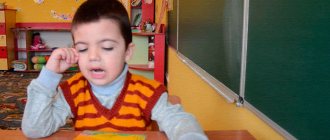Speech therapy presentation for PMPK for a 1st grade student,
Speech therapy presentation
per 1st grade student for PMPK
General sound of speech
: speech is incomprehensible, unformed intonation. The voice is quiet, muffled.
Lexicon:
significantly lags behind the age norm: ignorance of many words, the names of animals and their cubs, clothes, furniture, professions is revealed
.
The active vocabulary is limited to everyday topics and is qualitatively inferior. Does not know how to use word formation tools. The stock of adjectives and adverbs is narrow and monotonous.
Generalizing concepts are formed at the everyday level. The passive vocabulary is much wider than the active one.
Sound pronunciation:
(l) - (l`), sh-sch, ts-t`, ts-ch, velar pronunciation p, p`, violation of softness of consonants: (“pat” - five).
Phonemic processes:
not formed. Phonemic development is significantly behind the norm. Even simple forms of phonemic analysis are missing. Often, when correctly reproducing the contour of words, the sound content is disrupted: rearrangement of syllables, sounds, replacement and assimilation of syllables (“morashki” - daisies, “kukika” - strawberry). Polysyllabic words are reduced.
I learned to identify sounds in words like (house, poppy, moon) when pronouncing the syllables and sounds clearly and protractedly.
Syllable structure
: grossly violated. I learned to reproduce a simple rhythm by clapping and tapping.
The lack of formation of the rhythmic structure of both words and phrases is accompanied by a violation of the melody, tempo, and rhythm of speech. During reflected pronunciation, he produces only an approximate outline, an unclear sound complex instead of a word, and uses several variants of distortion of the same word.
Can repeat two- and three-syllable words with straight syllables like (mom, dad, milk, car), one-syllable words like (poppy, house) without a combination of consonants.
Syllables and words are not pronounced together.
When reproducing words with a cluster of consonants, omissions of consonant sounds of the cluster, addition of vowels within the cluster and other distortions are observed (window - “yako”, boat - “loka” - star - “seeing”). Often, when correctly reproducing the contour of words, the sound content is disrupted: rearrangement of syllables, sounds, replacement and assimilation of syllables (“morashki” - daisies, “kukika” - strawberry). Polysyllabic words are reduced.
Grammatical structure
: There are gross errors in the use of grammatical structures; he uses only simple sentences.
He experiences many difficulties when using prepositional constructions: prepositions are omitted altogether, and the noun is used in its original form (“the book goes then” - the book lies
on the table).
Understands the meaning of prepositions (on, under), but does not use them in speech.
Makes mistakes when forming the genitive case form. Most often, the sentence structure uses nouns in the nominative case, and verbs in the infinitive form or in the third person singular or plural form.
The agreement between the verb and the noun in number (“the lessons are over”, “the girl is sitting”), in gender (“the mother bought it”, “the girl went to”, etc.) is broken. Past tense verbs in speech are replaced by present tense verbs (“Vitya painted the house” , instead of “Vitya is drawing a house”).
Adjectives are used extremely rarely and do not agree with the nouns in gender and number (“red ribbon”, “delicious mushrooms”). Forms of nouns, adjectives and neuter verbs are missing, replaced or distorted.
Connected speech:
not formed.
Spontaneous speech is not intelligible .
Reading
: knows letters, reads syllables. When reading, substitutions are observed, adding letters at the end of words, and a violation of the softness of consonants. From the words I read, I understood individual words that have a simple syllable structure (lemons, raspberries). Doesn't understand the phrase he read.
Letters
o: Can copy words and short sentences without errors. Doesn't always translate printed letters into written ones. The work is slow.
I learned to write individual words from dictation while pronouncing them clearly and drawn out syllable by syllable.
There is a violation of the softness of consonants, replacement of t-ch.
Speech therapy conclusion: ONR-2. Motor alalia.
Date Speech therapist
multiurok.ru
Representation of a speech therapist teacher for a child (for PMPK)
Characteristics of a speech therapist teacher for a child (for primary care consultations)
Child's full name
Date of Birth
Address
No. DOW
Group
- Purpose of contacting PMPK
- Speech environment (speech deficiencies in adult family members, bilingualism)
- Early speech development (humming, babbling, first words, phrases, developmental development, whether speech development was interrupted)
- Was speech therapy assistance provided to the child (where, when?)
- Features of the structure and mobility of the articulatory apparatus
- State of respiratory and vocal function
- Sound pronunciation (isolated pronunciation, in words, phrases; substitutions, confusion, omissions, distortion of sounds - examples of speech)
- Phonemic perception (which sounds are not differentiated by acoustic characteristics, at the level of syllables, words; the state of phonemic analysis and synthesis)
- State of the dictionary (understanding of spoken speech, whether passive and active vocabulary is age-appropriate, there is no exact meaning of words, adjectives, pronouns are rarely used, etc.)
- The grammatical structure of speech (how it handles the function of inflection, word formation - examples of speech)
- Coherent speech (what phrases are used, the nature of the story, the presence of linguistic and expressive means)
- Symptoms of stuttering
Conclusion: Date: Speech therapist teacher: ( )
Loading...
logoportal.ru
Characteristics of a middle group child in a preschool educational institution from the teacher
The characteristics are compiled by the teacher whose group the child attends. The teacher fills out a special form where he indicates all the data:
- Full name, age.
- Does he often attend the group and does he like going to kindergarten?
- Relationship with other children and teachers, his character, attitude to classes, observance of personal hygiene rules.
- Does he perform the assigned tasks well, does he try hard in class, does he complete the work, does he need motivation to motivate him to take action?
- How the child behaves during the game, what roles he takes, how actively he participates.
Important! At the end, the teacher gives his assessment of the child’s psychological personality and describes what problem areas should be paid attention to.
Characteristics of a child with stuttering for PMPK
If there are any visible disorders of speech development, the child must be sent for an additional examination of the PMPK in order to exclude psychological developmental abnormalities. The most common reason for this deviation is stuttering. In this situation, the teacher must have a sample of filling out a speech card for a child with a speech disorder. The teacher should keep such a speech card from the day the first deviations were noticed.
The child stutters
The characteristics of a preparatory group child at the PMPK are supplemented with more detailed information about developmental deficiencies. It could be the following:
- Various speech convulsive manifestations;
- Moodiness, unreasonable fears, anxiety, mood swings;
- The movements of such children are unclear, uncertain, they are fussy, their fine motor skills are impaired;
- They are overly tired and irritable.
Street dancing for girls and boys for flash mob or graduation
The teacher describes in detail all the deviations and, based on them, draws his tentative conclusions.
Important! Speech therapy presentation to a child at the PMPK is an important step for the timely correction of developmental deficiencies.
Psychological and pedagogical characteristics of a group of children in a preschool educational institution
General psychological and pedagogical characteristics of a group of children in a preschool educational institution are carried out at certain intervals according to a pre-drawn up action plan. When compiling it, the striking characteristics of the child or the difficulties encountered are described.
Speech therapy commission in kindergarten
Characterization plan:
- where the child entered the institution and how long he has been attending it;
- family composition, relationships within, are there any difficulties in upbringing;
- How did you adapt to kindergarten?
- are there any features of appearance;
- what health group does he belong to?
- can he take care of himself?
- how he shows himself in gaming activities;
- how prepared you are for studying.
Important! In case of certain problems, the characteristics describe what successes the child achieved during the years of study at the preschool educational institution.
Characteristics of a kindergarten student: for whom and how is it compiled?
The teacher is responsible for characterizing the child. Most often, it is needed for admission to school, when visiting a psychiatrist, for registration of guardianship, and also when transferring to a speech therapy group or other institution.
This characteristic is an official document signed by all members of the commission with the seal and signature of the head.
When compiling it, the teacher relies on the completed curriculum and draws conclusions based on the skills acquired in its application.
Should I send my child to a speech therapy group?
Important! After a diagnosis of speech therapy is made, parents have a question: is it worth sending their child to a speech therapy group?
Very often they are afraid that during the PMPK the consultation will diagnose them with mental disorders. Firstly, this rarely happens, and secondly, early speech therapy examination of children gives a greater chance of correcting all deviations. Children are often diagnosed with FFID (phonetic-phonemic underdevelopment)
Individual lesson with a speech therapist
The effectiveness of being in a speech therapy group largely depends on the competence of the teacher and speech therapist. It is worth carefully studying the characteristics of the speech therapist teacher, whether he has received an award, and try to identify more reviews. The characteristics of a speech therapist teacher for awarding a diploma of honor are drawn up for a competent teacher with extensive work experience. It is also worth studying all the necessary documents, such as the Federal State Educational Standard (FSES).
Conclusions on the speech card of a speech therapy child
When studying the speech map, the speech therapist draws his conclusions, identifying the degree of development of the child and the level of education. Based on this, the child is assigned to the appropriate group. Often children in a speech therapy group come out more prepared for school than those in a regular group. This is achieved due to the fact that there are half as many children in this group, more attention is paid to them, classes with a speech therapist and other teachers are held every day, and the speech apparatus is constantly adjusted.
They begin to learn letter-sound analysis, sentence construction, and other skills necessary for school development earlier.
If a child has various abnormalities, the doctor refers him to a more specialized specialist. He, in turn, prescribes the necessary therapy. Timely treatment and early diagnosis can get rid of most problems with a child’s speech.
Speech therapy examination of a child
To determine the degree of development of the speech apparatus, it is simply necessary to carry out a speech therapy examination. This is necessary to identify disorders in the field of mental development.
Speech therapy group
During a speech therapy examination, two stages of diagnosis are carried out:
- General diagnostics, in which all components of development are checked: memory, thinking, attention, spatial imagination, etc.;
- Speech diagnostics, which tests speaking, writing, reading and memory.
During the examination, in addition to the diagnosis itself, a consultation meeting with parents is held. After this, a conclusion is drawn up and, together with the parents, a further method of correcting the violations is planned.
Parent consultation
The examination itself begins with a conversation, during which the speech therapist tries to establish contact with the child, and at the same time determines whether he understands him, whether he speaks in phrases or answers in monosyllables, whether he pronounces words clearly or not. At this time, the speech therapist makes an impression of general mental development. Then, based on the conclusions made, the doctor conducts a full comprehensive diagnosis using asked questions, pictures, objects and other materials.
What is the frequency of speech therapy examination of a child?
The frequency of this diagnostic is set by the teacher individually, based on the duration of the methods used. An earlier examination takes place upon admission to school, kindergarten and as part of the educational institution's plan.
Important! This usually happens in September to schedule the curriculum for the coming academic year.
There are also identified violations that require close attention. Then a PMPC is appointed - a psychological-medical-psychological commission. In such situations, a speech therapy presentation for a preschooler at the PMPK is carried out by a special commission created, during which previously made diagnoses (usually mental retardation or delayed psychological development) are confirmed or rejected.
PMPC





